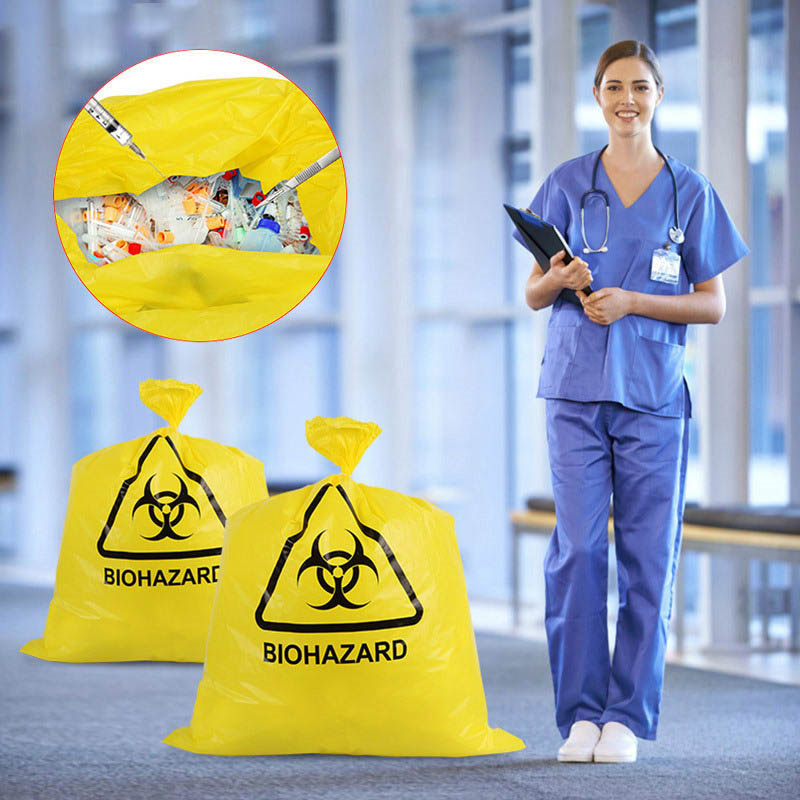
Medical waste is divided into infectious waste, damaging waste, pharmaceutical waste, chemical waste and pathological waste.
Infectious waste
Infectious waste refers to medical waste that carries pathogenic microorganisms and has the risk of causing the spread of infectious diseases.
1. Items contaminated by the patient's blood, body fluids and excrement, including: cotton balls, cotton swabs, drainage tampons, gauze and other dressings; disposable sanitary products, disposable medical supplies and disposable medical equipment; waste clothing; other items contaminated by the patient's blood, body fluids, and excrement.
2. Domestic garbage generated by quarantined infectious disease patients or suspected infectious disease patients admitted to medical institutions.
3. Pathogen culture medium, specimens and strains, virus strain preservation solution.
4. Various discarded medical specimens.
5. Waste blood and serum.
6. Disposable medical supplies and disposable medical devices after use are regarded as infectious waste.
Treatment method:
1. Collect in yellow medical trash cans with lids, and cover with special yellow medical garbage bags. When the container is 3/4 full, the garbage bag is sealed and a special label is attached.
2. The pathogen culture medium, specimens, strains, and virus strain preservation solutions in the microbiology laboratory shall be sterilized by pressure steam at the place of production and then collected as infectious wastes.
3. Waste urine, pleural and ascites fluid, cerebrospinal fluid and other specimens can be directly discharged into the sewer with sewage treatment system.
4. Discarded blood, serum, fecal specimens, and other infectious wastes should be placed in medical garbage bags and covered medical trash cans.
5. Blood transfusion bags should be collected separately in yellow medical garbage bags 24 hours after blood transfusion.
6. The waste (including domestic waste) generated by isolated infectious patients or suspected infectious patients should be tightly packed in double-layer yellow medical garbage bags.
Damaged waste
Damaged waste refers to discarded medical sharps that can stab or cut the human body.
1. Discarded metal sharps, such as medical needles, suture needles, acupuncture needles, probes, puncture needles and various guide wires, steel nails, surgical saws, etc.
2. Discarded glass sharps, such as coverslips, slides, glass ampoules, broken glass test tubes.
3. Discarded sharps of other materials, such as disposable tweezers, disposable probes, disposable plastic pipette tips, etc.
Treatment method:
1. Damaged waste (medical sharp instrument waste), put it into a yellow sharps box with a warning sign of medical waste, and mark "damaged waste" on the side of the box. Note: Choose a sharps box of suitable size, fill it with 3/4 and seal it for transport. 2. The full-loaded sharps box falls vertically from a height of 1.5m to the concrete floor for three consecutive times, and the sharps box will not be broken or punctured.
Pharmaceutical waste
Pharmaceutical waste refers to expired, obsolete, spoiled or contaminated waste medicines.
1. Discarded general medicines, such as antibiotics, over-the-counter medicines, etc.
2. Abandoned cytotoxic and genotoxic drugs, including: carcinogenic drugs such as azathioprine, chlorambucil, cyclosporine, cyclophosphamide, selimus Ting, tamoxifen, thiotepa, etc.; suspected carcinogenic drugs, such as: cisplatin, mitomycin, doxorubicin, phenobarbital, etc.; immunosuppressive agents.
3. Abandoned vaccines, blood products, etc.
Treatment method:
1. Batches of expired, eliminated, deteriorated or contaminated waste drugs should be collected and registered by the Department of Pharmacy, and then returned to the manufacturer or handed over to a hazardous waste disposal agency for disposal. 2. A small amount of pharmaceutical waste—including discarded cytotoxic drugs and genotoxic drugs vials can be directly put into medical waste bags and medical trash cans for infectious waste, but should be marked on the label.
Chemical waste
Chemical waste refers to waste chemicals that are toxic, corrosive, flammable and explosive.
1. Discarded chemical reagents used in medical imaging experiments. Waste chemical disinfectants such as peracetic acid and glutaraldehyde.
2. Discarded appliances and articles containing heavy metal substances, such as mercury-containing sphygmomanometers, mercury-containing thermometers, and mercury-containing articles after use in stomatology, etc.
Treatment method:
batches of waste chemical reagents (such as ethanol, formaldehyde, xylene, etc.) should be handed over to a specialized hazardous waste disposal agency for disposal. When medical devices such as mercury-containing thermometers and sphygmomanometers are scrapped in batches, they should be handed over to specialized hazardous waste disposal institutions for disposal.
Pathological waste
Pathological waste refers to human waste and medical experimental animal corpses generated in the process of diagnosis and treatment.
1. Abandoned human tissues, organs, etc. generated during surgery and other diagnosis and treatment processes.
2. Tissues and corpses of medical laboratory animals.
3. Discarded human tissue, pathological wax blocks, etc. after pathological sectioning.
4. The placenta of pregnant women with infectious diseases, suspected infectious diseases and sudden infectious diseases of unknown cause.
5. A stillborn fetus with a gestational age of less than 16 weeks or a fetal weight of less than 500 grams.
Disposal method:
Directly put into medical waste bags and covered medical trash cans. Fetal remains and infant remains shall be included in the management of remains in accordance with the Regulations on Funeral and Interment Management. It is strictly forbidden to dispose of the remains of fetuses and infants with a gestational age of more than 16 weeks or a fetal weight of more than 500g as medical waste.
The placenta after childbirth is owned by the mother, and no unit or individual may buy or sell the placenta. Before giving birth, mothers should go through placenta processing procedures with medical institutions and file them with medical history for future reference.














